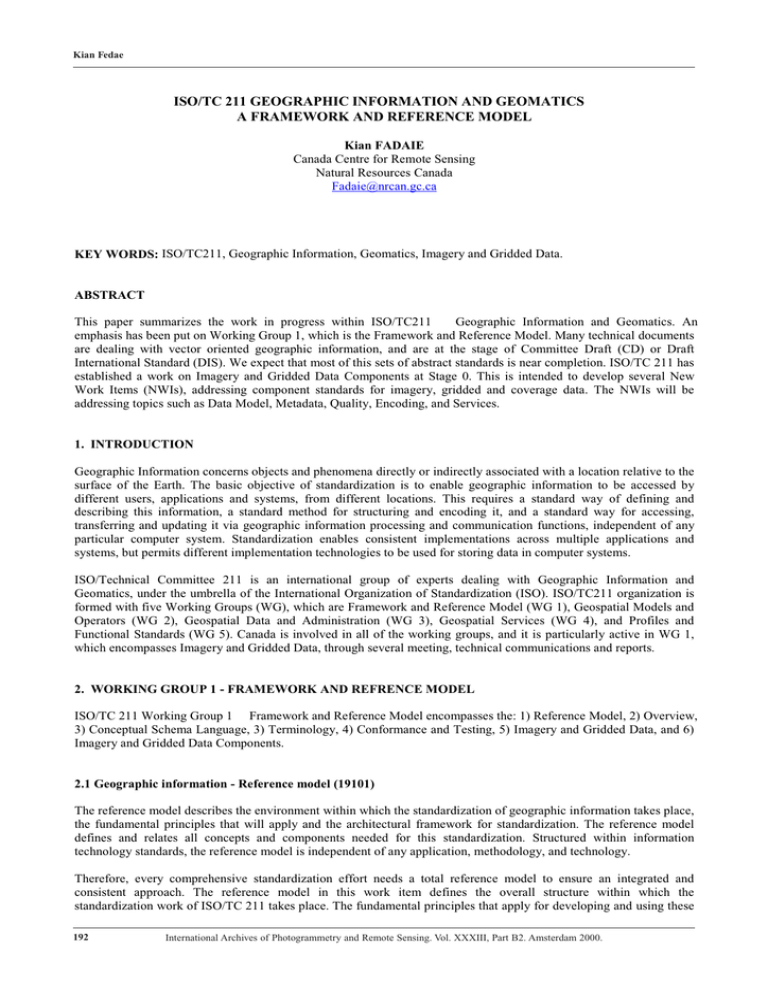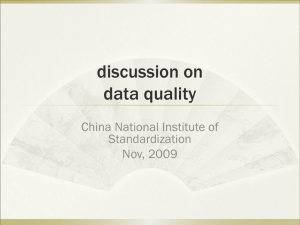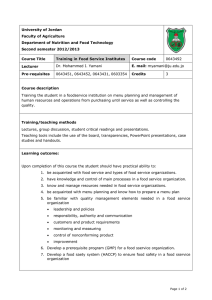ISO/TC 211 GEOGRAPHIC INFORMATION AND GEOMATICS A FRAMEWORK AND REFERENCE MODEL
advertisement

Kian Fedae ISO/TC 211 GEOGRAPHIC INFORMATION AND GEOMATICS A FRAMEWORK AND REFERENCE MODEL Kian FADAIE Canada Centre for Remote Sensing Natural Resources Canada Fadaie@nrcan.gc.ca Paper number 1734 KEY WORDS: ISO/TC211, Geographic Information, Geomatics, Imagery and Gridded Data. ABSTRACT This paper summarizes the work in progress within ISO/TC211 Geographic Information and Geomatics. An emphasis has been put on Working Group 1, which is the Framework and Reference Model. Many technical documents are dealing with vector oriented geographic information, and are at the stage of Committee Draft (CD) or Draft International Standard (DIS). We expect that most of this sets of abstract standards is near completion. ISO/TC 211 has established a work on Imagery and Gridded Data Components at Stage 0. This is intended to develop several New Work Items (NWIs), addressing component standards for imagery, gridded and coverage data. The NWIs will be addressing topics such as Data Model, Metadata, Quality, Encoding, and Services. 1. INTRODUCTION Geographic Information concerns objects and phenomena directly or indirectly associated with a location relative to the surface of the Earth. The basic objective of standardization is to enable geographic information to be accessed by different users, applications and systems, from different locations. This requires a standard way of defining and describing this information, a standard method for structuring and encoding it, and a standard way for accessing, transferring and updating it via geographic information processing and communication functions, independent of any particular computer system. Standardization enables consistent implementations across multiple applications and systems, but permits different implementation technologies to be used for storing data in computer systems. ISO/Technical Committee 211 is an international group of experts dealing with Geographic Information and Geomatics, under the umbrella of the International Organization of Standardization (ISO). ISO/TC211 organization is formed with five Working Groups (WG), which are Framework and Reference Model (WG 1), Geospatial Models and Operators (WG 2), Geospatial Data and Administration (WG 3), Geospatial Services (WG 4), and Profiles and Functional Standards (WG 5). Canada is involved in all of the working groups, and it is particularly active in WG 1, which encompasses Imagery and Gridded Data, through several meeting, technical communications and reports. 2. WORKING GROUP 1 - FRAMEWORK AND REFRENCE MODEL ISO/TC 211 Working Group 1 Framework and Reference Model encompasses the: 1) Reference Model, 2) Overview, 3) Conceptual Schema Language, 3) Terminology, 4) Conformance and Testing, 5) Imagery and Gridded Data, and 6) Imagery and Gridded Data Components. 2.1 Geographic information - Reference model (19101) The reference model describes the environment within which the standardization of geographic information takes place, the fundamental principles that will apply and the architectural framework for standardization. The reference model defines and relates all concepts and components needed for this standardization. Structured within information technology standards, the reference model is independent of any application, methodology, and technology. Therefore, every comprehensive standardization effort needs a total reference model to ensure an integrated and consistent approach. The reference model in this work item defines the overall structure within which the standardization work of ISO/TC 211 takes place. The fundamental principles that apply for developing and using these 192 International Archives of Photogrammetry and Remote Sensing. Vol. XXXIII, Part B2. Amsterdam 2000. Kian Fedae standards are described. The reference model also describes how the standards developed by ISO/TC 211 fit into this structure. This will promote the widest possible interoperability among geographic information applications and will allow these applications to be integrated with the widest possible array of information technology applications and services. The reference model is used by the ISO/TC 211 work groups to guide their work, by related standards bodies to identify potential overlap in standards activity, and by the geographic information community to understand the work of ISO/TC 211. The reference model will be revised as the standards work progresses. 2.2 Geographic information Overview (19102) Standardization within ISO/TC 211 will lead to a comprehensive family of standards. This overview provides a reference to the suite of geographic information standards developed by ISO/TC 211. This will allow potential users to understand each standard in the suite and how they relate to each other and will enable all users of geographic information to identify quickly which ISO/TC 211 standards are required for their application. The overview will promote better understanding and acceptance of the standards. The overview cannot be completed until the initial suit of standards has been identified and developed. The completion date for this work item is targeted to 2002. 2.3 Geographic information - Conceptual schema language (19103) The scope of the conceptual schema language includes the adoption of a conceptual schema language (CSL) for use in development of conceptual schemata in the field of geographic information. A single standardized conceptual schema language will promote the development of interoperable standards and will provide a foundation for the accelerated development of conceptual schemata and standards based on such schemata. Existing conceptual schema languages are taken into account, and the current state of the art in modeling has been taken into account in the choice of the Universal Modeling Language (UML) as the modeling technique used in TC 211. The conceptual schema language standard also defines the basic data types used in the models in the other parts of the suite of TC 211 standards. 2.4 Geographic information Terminology (19104) The terminology project scope covers the harmonization of all specific terms that relate to the ISO/TC 211 family of standards. The purpose of this activity is standardization of the terminology used in the ISO/TC 211 suite of standards. Creation of a common set of terms for geographic information standards will be an important foundation for the work groups of ISO/TC 211 in the development of an integrated suite of standards. Standardized terminology will also help standards users, especially geographic information system and software developers who will implement the ISO/TC 211 standards. This task is generally feasible and needed now, but the existing use of multiple terms for the same concept or a single term for different concepts within the field of geographic information and related fields make this a difficult task. The work is promoting international understanding of geographic information standards and better understanding of geographic information concepts among other disciplines. Geographic information terminology should be harmonized with both Information Technology and Data Management terminology. Work began on this project at the beginning of the work in TC 211, but by its nature it cannot be completed until a late date (targeted date is 2001). 2.5 Geographic information - Conformance and testing (19105) The conformance and testing document deals with the framework, concepts, and methods for testing and criteria to be achieved to claim conformance to the ISO/TC 211 family of standards. Standardization of testing methods and criteria for conformance to selected geographic information standards will allow developers of geographic information systems and software to verify conformance to those standards. Verifiable conformance will be important to geographic information users. International Archives of Photogrammetry and Remote Sensing. Vol. XXXIII, Part B2. Amsterdam 2000. 193 Kian Fedae Conformance standards will not be needed until the standards are implemented, but to the extent possible, criteria for testing and conformance are considered by the ISO/TC 211 work groups during the development of selected standards. This standard has already progressed to the Draft International Standard (DIS) stage. 2.6 Geographic information Imagery and gridded data (19121) The imagery and gridded data project has developed a type 3 technical report, which addresses the manner by which TC 211 should handle imagery and gridded data in the context of the field of Geographic information/Geomatics. The document identifies those aspects of imagery and gridded data that have been standardized or are being standardized in other ISO committees and external organizations that influence or support the establishment of raster and matrix data standards for geographic information. Hence, it has developed a plan for TC 211 to address Imagery and gridded data in an integrated manner, within the suite of TC 211 base standards. ISO/TC 211, in Resolution 38, has recognized the importance of Raster and Matrix Data in the field of Geographic Information/Geomatics. As the number of producers of Imagery and Gridded Data products increases the need for standardization with respect to Geographic Information in the form of Raster and Matrix Data also increases. Imagery is also being studied in a number of other ISO and external standards organizations in other contexts, such as Medical Imagery, Digital Television, Picture Coding etc. ISO/TC 211 has to review these external standards in order to develop its suite of base Geographic Information/Geomatics standards in a compatible manner. It also needs to influence these external standards developments to ensure that they cover TC 211 requirements. The Technical Report, ISO/TC 211 N752 (19121, Geographic Information Imagery and Gridded data) provides information to assist ISO/TC 211 for including the topic of image and gridded data within the suite of ISO 19100 standards. This technical report reviews the manner in which raster and gridded data is currently being handled in the Geomatics community in order to propose how this type of data should be supported by the 19100 suite of standards. The technical report ISO 19121 identifies the following data formats as having an influence on Imagery and Gridded Data: • • • • • • • • • • • • • ISO/IEC JTC1/SC24 - Computer Graphics and Image Processing (IP-IIF and BIIF) ISO/IEC JTC1/SC29 - Coding of Audio, Picture, and Multimedia and Hypermedia Information ISO/IEC JTC1/SC32 WG3 SQL/MM Structure Database Languages ISO TC130 Graphic Technology (TIFF) DIGEST (DIgital Geographic Exchange STandard) Spatial Data Transfer Standard: Part 5: Raster Profile IHO S-57 - International Hydrographic Organization Transfer Standard for Digital Hydrographic Data CEOS Committee on Earth Observation Satellites EOSDIS/HDF/HDF-EOS International Telegraphic Union Telecommunications ITU-T SG VIII - T.4 and T.6 Open GIS Consortium (OGC) - Coverages Private Formats Tag Image File Format (TIFF, and GeoTIFF) Some of these format address only narrow aspects of data exchange whereas others represent entire data exchange formats for satellite or other image or gridded data. The report ISO 19121 identifies those aspects of imagery and gridded data that have been standardized or are being standardized in other ISO committees and external standards organizations, and that influence or support the establishment of raster and gridded data standards for geographic information. Each of the existing imagery and gridded data standards is described with respect to the ISO/TC 211 work items, and the elements of those external standards that should be considered by the ISO/TC 211 project teams are identified. Based on input from experts on the various existing related standards, a cross-reference table identifying a number of characteristics that apply to each of these standards was developed. The report also describes the components of those identified ISO and external imagery and gridded data standards that can be harmonized with the ISO/TC 211 Geographic information/Geomatics standards. A plan is presented for ISO/TC 211 to address imagery and gridded data in an integrated manner, within the suite of ISO/TC 211 base standards. ISO/TC 211, in Resolution 81, indicated that the most appropriate way of handling the recommendations presented in the Technical Report 19121 is to begin the work on Imagery and gridded data in a new 194 International Archives of Photogrammetry and Remote Sensing. Vol. XXXIII, Part B2. Amsterdam 2000. Kian Fedae standard at the preparatory Stage 0. In addition a related new work item on Coverage Geometry and Functions is to be developed, which takes into account the Technical Report 19121. The initial emphasis is to be on imagery (both synthetic and natural), and gridded data such as digital elevation models. The target dates of the ISO/TC211 Framework and Reference Model program of work are as follow (table 1). Project no WD CD 2.CD 3.CD 19101 19102 19103 19104 19105 19121 1996-03 1996-09 1996-01 1996-09 1996-09 1998-01 1998-07 1999-07 1999-05 1998-04 PDTR 1998-07 1998-12 1999-04 2000-05 1999-11 1998-10 DTR 1999-06 19124 Stage 0 Table 1. Target dates of ISO/TC 211 2000-05 DIS FDIS IS 2000-06 2001-09 2001-01 2002-05 2000-11 1999-08 2001-06 2000-03 2001-03 2002-07 TS 2000-11 2001-08 2000-05 TR 2000-03 ER 2001-01 Framework and Reference Model WD = Work Draft, CD = Committee Draft, 2/3.CD = Committee Draft version 2 or 3, DIS = Draft International Standard, FDIS = Final Draft International Standard, IS = International Standard, PDTR = Proposed Draft Technical Report, DTR = Draft Technical Report, TR = Technical Report, ER = Evaluation Report. Most of these documents are dealing with vector oriented geographic information, and are at the stage of Committee Draft (CD) or Draft International Standard (DIS). We expect that most of these sets of abstract standards are near completion. ISO/TC 211 has established a work on Imagery and Gridded Data Components at Stage 0. It will produce an Evaluation Report that recommends new work items to the Technical Committee. 2.7 Geographic information Imagery and gridded data components (19124) The aim of this topic is to standardise concepts for the description and representation of imagery and gridded data in the context of the ISO 19100 suite of standards. This includes new work on the following aspects of such data: Rules for application schemas, Quality principles and Quality evaluation procedures, Spatial reference systems, Visualisation, and Exploitation services. The work will also identify aspects of existing parts of the family of standards that need to be expanded to address imagery and gridded data. New metadata elements will be defined using the extension mechanism of ISO 19115. Methods of encoding imagery and gridded data will be identified for inclusion in ISO 19118. ISO/TC 211 Working Group 1 members have provided information papers on different formats, namely DIGEST, IHO raster, BIIF, NITF, SQL/MM Image, OGC, SC 29, T4 and T6, TC 130 TIFF, GeoTIFF, SDTS raster, CEOS, HDF, HDF-EOS, FGDC Swath, FGDC Remote Sensing metadata, ISPRS (ITS) and SDS. In fact, a series of white papers were submitted and relevant components have been identified into five categories: Data Models/Schema, Metadata, Encoding, Services, and Spatial Registration. The result of Stage 0 Work Item will be a set of three to five New Work Item Proposals for ISO/TC 211, covering both abstract and detailed work required for Imagery, Gridded and Coverage data. Detailed work will encompass some of these topics: • • • • Data Model, including sensor model, based on ISPRS, HDF-EOS, FGDC, NITF, OGC and IHO; Metadata document ISO/TC 211 19115 review against the relevant formats/standards; Mapping of TC211 conceptual schema for Imagery and Gridded Data into multiple encoding formats; and Visualization of Imagery and Gridded Data. 4. CONCLUSION ISO/TC 211 19100 suite of standards are generic and provide the building blocks for practical use. The work in ISO TC211 to develop Geographic Information / Geomatics standards is integrating the efforts of experts from a number of different nations toward the goal of interoperability. Application and sector specific standards are being replaced by universal standards that address a broad range of requirements. Formal modeling techniques are being used to ensure that the component standards actually work together, and that implementation costs are reduced. International Archives of Photogrammetry and Remote Sensing. Vol. XXXIII, Part B2. Amsterdam 2000. 195 Kian Fedae The initial thrust of TC 211 was toward vector based standards. The current work on Imagery and Gridded Data Components is adding standardization of imagery to the mix. The work on a common Coverages schema builds a mathematical basis for imagery, matrix data such as digital terrain models, TIN and other similar types of data. The Imagery and Gridded Data work defines the common components of metadata, sensor models, geodetic positioning for sensors, to the generic TC 211 work. Several encodings currently exist, and will continue to exist for Imagery and Gridded Data. These encodings are defined in external standards such as the ISO JTC1 SC24 Basic Imagery Interchange Format (BIIF). However, the common models defined in TC 211 separates the content from the carrier, allowing different encodings to be used for different purposes. ISPRS has a liaison relationship with TC 211, and experts from ISPRS have contributed to the work on Imagery and Gridded Data, especially with respect to sensor models. Additional participation is welcome. REFERENCES CEN TC 287 CR 287002, 1998. Geographic Information Fundamentals Overview, 13 p. ISO/TC 211 N 623, 1998. CD 19101 Geographic Information Reference model, 46 p. ISO/TC 211 N 723, 1999. CD 19102 Geographic Information Overview, 17 p. ISO/TC 211 N 755, 1999. CD 19103 Geographic Information Conceptual schema language, 75 p. ISO/TC 211 N 735, 1999. CD 19104 Geographic Information Terminology, 23 p. ISO/TC 211 N 719, 1999. CD 19105 Geographic Information Conformance and testing, 28 p. ISO/TC 211 N 752, 1999. 2. PDTR 19121 Geographic Information ISO/TC 211 N 617, 1998. New work item proposal 6 p. Imagery and gridded data, 43 p. Geographic Information Imagery and gridded data components, ISO/TC211 Geographic Information/Geomatics 2000. http://www.statkart.no/isotc211/ (15 March 2000). 196 International Archives of Photogrammetry and Remote Sensing. Vol. XXXIII, Part B2. Amsterdam 2000.




